FILLMORE EAST - PLAYGROUND PSYCHOTICS: COMEDY SHOWS WITH FLO AND EDDIE
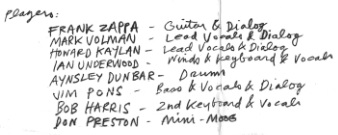 Zappa became impressed by Flo and Eddie's vocal abilities and gave them the
central role for his next three albums. They went touring for
two years as the eye catchers of the second line up of the Mothers of Invention. Recordings from these live performances
are available on three CDs, "Fillmore East, June 1971", "Just another band from L.A." and a
documentary like double CD "Playground psychotics". At this time the lyrics had for several episodes become the main
dish with Flo and Eddie behaving like comedians. With these lyrics Zappa tried to entertain as well
as shock his public, including disgusting sexual acts, a song about god on a sofa floating through the
universe and a story about a mountain being drafted (the sofa episode can be found on "You can't do that on stage
anymore vol. I").
They set the tone for his habit of describing sex in an unromantic pornographic way. The music during the dialogue
parts of the live performances didn't have an important role, sometimes being no more than some vamping
background accompaniment as in "Do you like my new car" or pausing a moment as occasionally done during
"Billy the mountain". To the right the line-up of the 1971 band, playing at the Fillmore East. It's an outtake from the
album cover, that is totally drawn/written in this manner.
Zappa became impressed by Flo and Eddie's vocal abilities and gave them the
central role for his next three albums. They went touring for
two years as the eye catchers of the second line up of the Mothers of Invention. Recordings from these live performances
are available on three CDs, "Fillmore East, June 1971", "Just another band from L.A." and a
documentary like double CD "Playground psychotics". At this time the lyrics had for several episodes become the main
dish with Flo and Eddie behaving like comedians. With these lyrics Zappa tried to entertain as well
as shock his public, including disgusting sexual acts, a song about god on a sofa floating through the
universe and a story about a mountain being drafted (the sofa episode can be found on "You can't do that on stage
anymore vol. I").
They set the tone for his habit of describing sex in an unromantic pornographic way. The music during the dialogue
parts of the live performances didn't have an important role, sometimes being no more than some vamping
background accompaniment as in "Do you like my new car" or pausing a moment as occasionally done during
"Billy the mountain". To the right the line-up of the 1971 band, playing at the Fillmore East. It's an outtake from the
album cover, that is totally drawn/written in this manner.
FILLMORE EAST - JUNE, 1971
1. Little house I used to live in (1971)
The Fillmore East version of "Little house I used to live in" is much different
from the preceding "Burnt weeny sandwich" rendition, included in this study as
"The little house I used to live in (1970)".
It has a newly composed introduction and the main theme is instrumentated differently, as well
as containing variations and different harmonizations.
The first version gets dealt with in the Burnt weeny sandwich section. The second example below is a transcription of themes 3-4 by W. Ludwig. On the
"Burnt weeny sandwich" album bars 44-65 are played between 2:51 and 3:39, corresponding with 2:34 through 3:18 on "Fillmore East".
To a degree the introduction on "Fillmore East" contains variations upon this material:
The little house I used to live in (1971), 0:00-0:12 (midi file).
The little house I used to live in (1971), 0:00-0:12 (transcription).
The little house I used to live in, themes 3-4 (transcription).
- 0:00 The downwards line from bars 44-45, starting with A, can also be recognized here in bar one.
In this case with an additional B. The melody follows A-B-A-G-F#-E-D-C. Also here the tonic is A, though
the melody is following the A Dorian scale. Bar two contains a set of triads.
- 0:07 Some improvisations, at first continuing in A minor. The meter switches from 6/4 to 4/4.
The first transcription below contains the opening bars of the 1971 version till Zappa joins in on guitar in bar 7.
- 0:24 The opening line returns.
- 0:32 Some more improvisations.
- 0:46 The melody from bar 1 returns, much slower and in a different rhythm.
- 1:06 The downwards line some more, now played really fast.
- 1:08 Figures, specific for the "Fillmore East" version.
- 1:38 The main theme from "The little house I used to live in" starts.
2. The mud shark
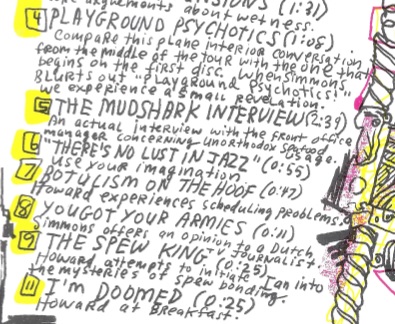 On stage the groupie life became one of the themes, that gradually developed into
something of a mini opera. The CD re-release
improved the idea of a series of songs about the bizarre sex life of groupies, because
the awkward way it was cut in half on the album could now be avoided. It's also better mixed.
"The mud shark" sets off the opera with Zappa telling the audience about a video members of the Vanilla Fudge made
about some unusual sexual behaviour. "Playground psychotics" contains "The mud shark interview" with Zappa asking
a member of the hotel staff if they were aware things like this actually happened in their hotel (to the left part of the CD
tracklist). Musically it's Zappa talking over a vamp. He would do that more often later on. Sometimes just regularly talking. Sometimes with a
melody derived from enlarging the intervals of spoken language, or flattening sung melodies, depending how you look at it.
Zappa called it meltdowns.
On stage the groupie life became one of the themes, that gradually developed into
something of a mini opera. The CD re-release
improved the idea of a series of songs about the bizarre sex life of groupies, because
the awkward way it was cut in half on the album could now be avoided. It's also better mixed.
"The mud shark" sets off the opera with Zappa telling the audience about a video members of the Vanilla Fudge made
about some unusual sexual behaviour. "Playground psychotics" contains "The mud shark interview" with Zappa asking
a member of the hotel staff if they were aware things like this actually happened in their hotel (to the left part of the CD
tracklist). Musically it's Zappa talking over a vamp. He would do that more often later on. Sometimes just regularly talking. Sometimes with a
melody derived from enlarging the intervals of spoken language, or flattening sung melodies, depending how you look at it.
Zappa called it meltdowns.
The mud shark, 4:17-4:45 (midi file).
The mud shark, 4:17-4:45 (transcription).
From 3:39 onwards the mud shark story is finished and the band continues singing the vamp as they are doing in bars 1-4 from above, staves 1-3.
From bar 5 onwards the instrumentalists are joining in more explicitly, at first with a variation upon theme 3 from the previous song (see above).
While "The mud shark" has been stable in E Dorian so far, these instrumental themes come in as a surpise by using a G#. It's a beautiful example
of blending E Dorian and E Mixolydian. Right through each other, thus including the G natural-G# dissonance caused by it.
3.What kind of girl do you think we are?
"What kind of girl do you think we are?" follows the blues scheme for both the verse and chorus. In case of the verse the bass is playing
as a walking bass, in case of the chorus giving pedal notes. The example below is the end of this song, to be heard between 3:24 and 4:17.
It's not in one particular key. The example starts with following E major and continues with using E Mixolydian and Dorian next to each other.
What kind of girl do you think we are?, end (midi file).
What kind of girl do you think we are?, end (transcription).
It contains:
Second half of the verse:
- Bars 1-2: step I of the blues scheme.
- Bars 3: step V.
- Bars 4: step IV, with the A only touched upon at the beginning.
- Bars 5-6: step I.
First half of the chorus:
- Bars 7-10: step I, with the chorus following the chord progression E-F#m-G-F#-E-F#m-E on top of it.
- Bars 11-12: step IV, with the chorus following the same progression with Em instead of E.
- Bars 13-14: step I.
Instead of completing the scheme, this song segues into "Bwana Dik", causing the last bar to become 7/8.
"What kind of girl do you think we are?" would re-appear years later on "Broadway the hard way", introduced
by a couple of bars with striptease music. The opening of that particular version of
"What kind of girl?" is included in the corresponding section, including the striptease music,
not present in the 1971 version.
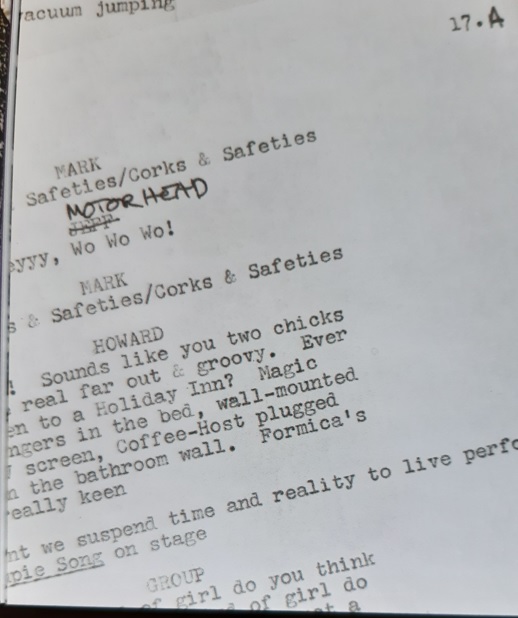
Sample from the 200 Motels script as shown in the ZFT release "200 Motels, 50th anniversary edition". The so-called groupie opera, tracks
3-8 from "Fillmore East, June 1971", was orginally intended to be the centerpiece of "200 Motels", with studio demo recordings being included in
disc 2 of this release. Because of the limited shooting time, much had to be skipped.
4. Bwana Dik
"Bwana Dik" is one of Zappa's songs in the tradition of "Brown shoes don't make it", where he's
using many themes in different tempi, different keys and different meters. Of the original songs on "Fillmore East",
this one is the most divers. It's the opposite of the two vamp-based pieces, "Mud shark" and "Do you like
me new car", where the lyrics stand central.
Bwana Dik, section (midi file).
Bwana Dik, section (transcription).
The transcribed section goes as:
- Bars 1-7: slow variation upon the "Duodenum" theme as played at the end (tempo I, 4/4), now with lyrics. See the Projects section for the original
"Duodenum" version. Just as "Duodenum" it's in E Dorian and it ends chromatically.
- Bar 8: one pick-up bar in 2/4 for the next theme in tempo II, faster.
- Bars 9-19: second block in 4/4 using varying scales. It begins with the chord progression C-D-E-F-G in exact parallels (bars 9-13),
thus all five chords are major 5th chords. Bars 14-15 repeat the tail of this progression. Bars 16-19 are in C Lydian.
- Bars 20-22: instrumental passage in 2/2 with a string of 32nd notes. The tempo becomes a bit slower.
The keyboard part has exact pitches. Flo and Eddie follow it loosely without lyrics, because the human voice can't be precise in
this tempo.
- Bar 23-24: two pick-up bars in 4/4 for the next theme in tempo III, much faster.
- Bars 25-30: third theme block in 4/4. The melody here is built over a I-VII alternation in F# minor/Dorian. In bars 29-30 the tempo
is held back a little.
5. Latex solar beef - Junier Mintz boogie
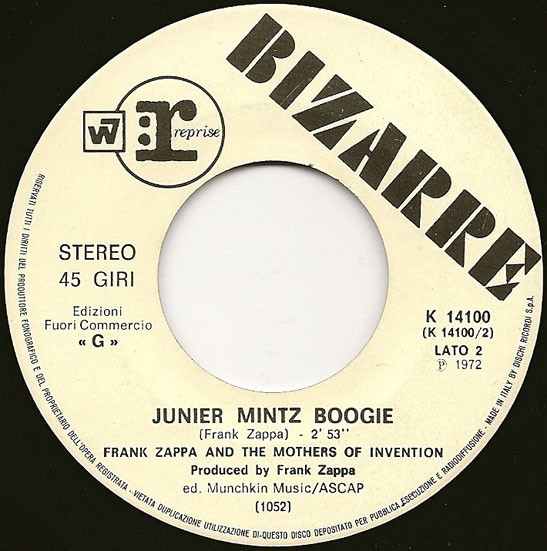 Next are two examples in 4/4 where Zappa is using syncopes and triplets to make the rhythm within
the meter more complicated. Whereas the main "Latex solar beef" theme has a regular rhythm, the accompanying figures are using syncopes on the fourth
beat. In the first bar they set in a 16th before the beat and then divide the remaining time into two; in the second bar the
"Mud shark" notes are played a 16th in front and after the beat.
Next are two examples in 4/4 where Zappa is using syncopes and triplets to make the rhythm within
the meter more complicated. Whereas the main "Latex solar beef" theme has a regular rhythm, the accompanying figures are using syncopes on the fourth
beat. In the first bar they set in a 16th before the beat and then divide the remaining time into two; in the second bar the
"Mud shark" notes are played a 16th in front and after the beat.
Latex solar beef, opening (midi file).
Willie the Pimp (1971), Latex solar beef variation (midi file).
Latex solar beef, opening (transcription).
Willy the pimp (1971), Latex solar beef variation (transcription).
The "Latex solar beef" theme returns in a variation
at the beginning of "Willie the Pimp". The first time "Latex solar beef" is played in B Dorian. The variation is in A
Dorian. It's the same key as "Willie the Pimp" is in, thus making the transition go smoothly.
Junier Mintz boogie, 0:16-0:46 (midi file).
Junier Mintz boogie, 0:16-0:46 (transcription).
In 2022 the ZFT released "The Mothers 1971" with all of the four Fillmore East concerts from June 1971 in it, next to the full Rainbow Theatre
concert from December that year and some more live recordings from June. Included as well is "Junier Mintz boogie", that got released as the b-side
of the "Tears began to fall" single (image above to the right). It's also recorded live, this time from a concert in Detroit, May 25th. Because of the bass vamp it has to be a
solo taken from a "Latex solar beef" performance. On this occasion it's played in the key of Bb Dorian.
6-7. Willie the pimp (1971), parts one and two
The slow main riff from "Willie the Pimp" (originally on "Hot rats") is in a normal rhythm. It neatly follows upon the "Latex solar
beef" variation, introducing a solo in between the vocal parts. It's a fine solo and the bootlegs from this period
(see the Beat the boots section) indicate that there were more of them. See the Hot rats section for more about "Willie the Pimp".
Willie the pimp (1971), theme (midi file).
Willie the pimp (1971), theme (transcription).
The bars above are in A Dorian, using the progression I-IV-III. "Willie the Pimp" is one of the
two instances were Zappa changed his opinions on CD by leaving something completely out. "Willie the Pimp" now got a more normal ending
and part II was removed, that is on the first Rykodisc CD edition, RCD 10521. The other instance concerns the synthesizer ending of
"I'm so cute" on "Sheik Yerbouti", which was shortened. The current ZFT edition, ZR3845, has part II resurfaced, bringing the number
of tracks back to 12 instead of 11, which I'm following here.
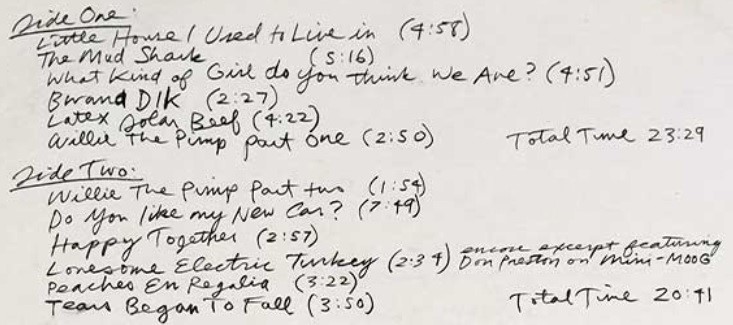
The original vinyl track list including "Willie the pimp part two" as the opener of side two.
In 2022 the ZFT released "The Mothers 1971" with the complete Fillmore East concerts from June 1971 on it. The Mothers played on June 5th and 6th, doing two shows
each night. The series of songs from "Little house I used to live in" through "Happy together" were played as one sequence that could never fit on one side of a vinyl
album. So Zappa decided to let "Willie the pimp" fade out on one side and fade in on the other side (version differences existed with an abrupt end/start instead of fading).
"The Mothers 1971" makes it possible to listen to the complete recordings, showing in what manner parts one and two were taken from different shows. The two examples below are
taken from around the splitting points. At the end of bar 7 from the first example "Willie the pimp part one" ends. The band continued the play for about a minute with Zappa playing something
what you might call an outro. At bar 3 from the second example "Willie the pimp part two" begins. When Zappa starts soloing the note density increases significantly, creating an
acceleration effect. The rhythm sections follows this in the first example by having started to play two downbeats during what was one bar at the beginning. I've still notated the first example below in 4/4,
but it should be played twice as fast as a 4/4 bar from the beginning. In the second example the meter remains 4/4 as at the beginning, but with the bass playing the A pedal
in an irregularly pulsing manner. The exact individual notes are hard to be discerned, the notation of the bass line is an indication only.
Willie the pimp (06-05-1971), 2:49-3:07 (midi file).
Willie the pimp (06-06-1971), 2:20-2:36 (midi file).
Willie the pimp (06-05-1971), 2:49-3:07 (transcription).
Willie the pimp (06-06-1971), 2:20-2:36 (transcription).
On "https://www.afka.net/Articles/1990-09_ICE.htm" you can find the following from ICE Watchdog October 1990, a newsleter, in this case by Pete Howard:
"We asked Zappa about the missing guitar part on "Willie the pimp" from Fillmore East, and the shorter
version of "I'm so cute" from the Sheik Yerbouti CD. About the former, he said, "I think it's more important that you have continuity on the CD.
The way that Fillmore East was constructed on vinyl, one side faded out and the other side faded in. The effect on the CD would be the guitar fading out and then back in,
so why not just have it fade down to the start of the next song?" Why didn't he go back to the multi-tracks and fuse the two parts together seamlessly?
"The two parts were not from the same performance", Zappa said, "so there would have been a tempo discrepancy right in the middle of a guitar solo.
I've also had complaints about the guitar solo on "Dumb All Over" (on the "You are what you is" CD). That's also unmeshable because it, too, was not a continuous performance.
I didn't like that guitar solo to begin with, but I think what's important is the lyrics, getting from one topic to another.
And in the case of "I'm So Cute" – I had to shorten it just to get the whole album on one CD. Better that than something more interesting musically, like "Yo Mama.""
There is indeed some difference between the tempos of the June 5th and 6th recordings, but Zappa had means at his disposal that he used for applying what he himself called xenochrony,
as well as a Sonic Solutions device, referred to at track 13 of disc 2 of "YCDTOSA Vol. VI". I guess it was a matter of available time as well.
8. Do you like my new car? - The groupie routine
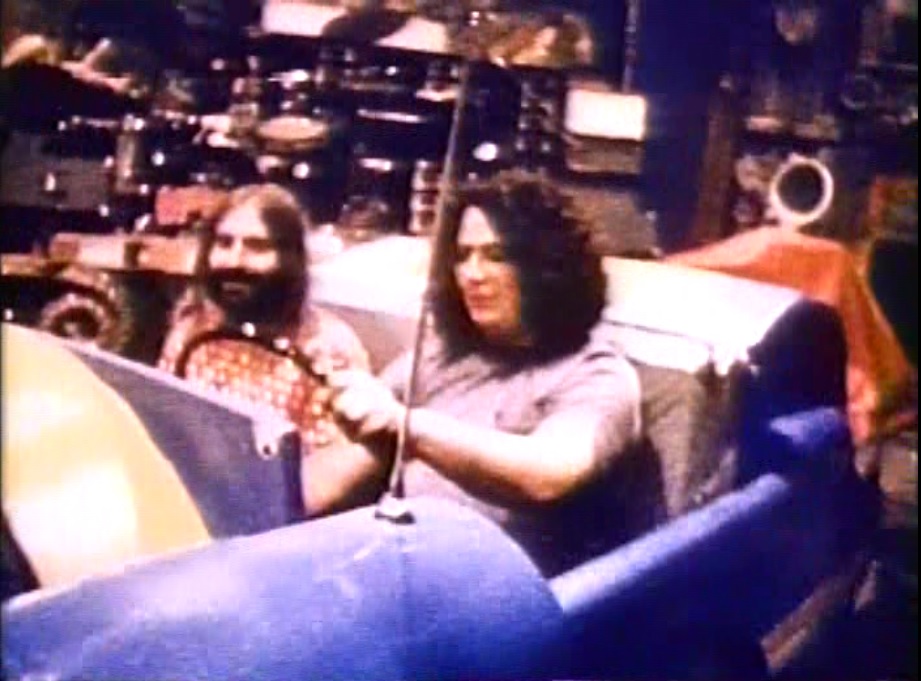 "Do you like my new car?" is the largest section with the lyrics standing central. In order not to interfere much with what's going on, the accompanying vamp is
deliberately kept simple. It's basically a I-II alternation in F# major or Mixolydian (the E/E# that makes the difference is (largely) absent).
Howard Kaylan plays the role of a groupie, while Mark Volman represents a popstar. The other people playing can be either other groupies or band members.
Howard's text is reproduced in staff 2 of the first example below and staff 1 of the second example. Mark is staff 1 in the first example. The "Do you like my new car?"
example is the section that includes an instrumental passage in F# Mixolydian. It's not specifically written for this song, but follows upon instances of when the text
goes as "... dick is a monster...". You can also hear it on "What kind of girl do you think we are?" and "Daddy, daddy, daddy" on the "200 Motels" album from the same year.
Here it is played via quintuplets over
a 2/4 meter. It follows the chord progression I-IV-VII-VII-[F]-[F#m]-I-I-I-VII-I. The F and F#m chords are added in as a chromatic passing through chords.
This track re-appears as "The groupie routine" on the "YCDTOSA vol. I" CD from the eighties, recorded only shortly afterwards.
"Do you like my new car?" is the largest section with the lyrics standing central. In order not to interfere much with what's going on, the accompanying vamp is
deliberately kept simple. It's basically a I-II alternation in F# major or Mixolydian (the E/E# that makes the difference is (largely) absent).
Howard Kaylan plays the role of a groupie, while Mark Volman represents a popstar. The other people playing can be either other groupies or band members.
Howard's text is reproduced in staff 2 of the first example below and staff 1 of the second example. Mark is staff 1 in the first example. The "Do you like my new car?"
example is the section that includes an instrumental passage in F# Mixolydian. It's not specifically written for this song, but follows upon instances of when the text
goes as "... dick is a monster...". You can also hear it on "What kind of girl do you think we are?" and "Daddy, daddy, daddy" on the "200 Motels" album from the same year.
Here it is played via quintuplets over
a 2/4 meter. It follows the chord progression I-IV-VII-VII-[F]-[F#m]-I-I-I-VII-I. The F and F#m chords are added in as a chromatic passing through chords.
This track re-appears as "The groupie routine" on the "YCDTOSA vol. I" CD from the eighties, recorded only shortly afterwards.
Do you like my new car?, background music, section (midi file).
The groupie routine, background music, opening bars (midi file).
Do you like my new car?, section (transcription).
The groupie routine, opening bars (transcription).
It shows that Flo and Eddie could keep
changing the text of their parts while the general idea remained the same. Musically this version differs mostly from the "Do you like my new car?" version
by letting the tempo of the vamp fluctuate. The opening bars in this case are in F# Dorian for bars 1-8, before the songs turns to the I-II alternation
in F# major/Mixolydian, where it stays for the rest of the song. The metronome tempo of a quarter note can be:
- "Do you like my new car?": 110 (constantly).
- "The groupie routine" opening bars: 130.
- "The groupie routine" at its fastest: 240.
- "The groupie routine" at its slowest: 90.
As Zappa writes in the liner notes: "The 1971 band performed this routine every night, and every night it changed a little. This L.A. version
has a few good variations in it." The two midi files above contain the instrumental parts only. The text in this case sounds too crappy in midi format to include it.
The transcriptions give the complete picture.
Above to the right: Flo and Eddie at Pinewood studios, trying out the Do you like my new car? scene for "200 Motels".
It didn't become a part of the actual movie. Source: The true story of 200 Motels.
9. Happy together
"Happy together" is the big hit Flo and Eddie had as lead singers of The Turtles, a song written by Binner and Gordon. Groupies belonged to Zappa's favorite pastime, but the folklore from "Fillmore East" is just as much or even more based upon what happened to The Vanilla Fudge and the Turtles after they got their "bullet" hit. Regarding the lyrics and context this song logically follows upon the previous track, where a groupie is requiring the singing of a big hit to have sex. The song itself takes up 0:00-1:40 from this track, lasting 2:57 in total. It was used as the concert closing song ending with Zappa thanking the audience, continuing with commenting upon the upcoming closing of the hall they are playing in: "in a way it's sad that Bill Graham is closing down the Fillmore, but uh, I'm sure he will get into something better".
10. Lonesome electric turkey - King Kong (1971)
"Lonesome electric turkey" is a collage with an outtake from a keyboard encore and experimental vocal sections. On the album cover
Don Preston gets credited for playing the keyboard solo and at one point you can recognize a phrase from the "King Kong" theme (0:17 through 0:22),
but being taken separate, you might ask if he shouldn't better have been co-credited as songwriter.
Lonesome electric turkey, 1:51-2:02 (midi file).
Lonesome electric turkey, 1:51-2:02 (transcription).
Don's solo, the "King Kong" part, is in D Dorian. The example above is the beginning of the experimental block. The D pedal continues. At first the other instruments are playing over
it with relatively low volumes in a chromatic manner, kind of mysteriously. It's rhythmically irregular, touching upon a limited number of pitches.
Next Don returns and the singers join in with glissando notes, swelling in volume.
The context of this outtake has become available through the ZFT release "The Mothers, 1971", where the complete encore of the 2nd show of June 5th, 1971, can
be listened at. This event gets subdivided as:
- Any chord of your choice. 1:44.
- King Kong part I. 4:22.
- Lonesome electric turkey. 2:34.
- King Kong part II. 19:37.
King Kong, part 2 (6-5-1971), 11:05-11:40 (midi file).
King Kong, part 2 (6-5-1971), 11:05-11:40 (transcription).
The section from above is the start of Zappa himself soloing, after a long period of Don Preston and Ansley Dunbar soloing.
Bars 1-8 contain a parallel playing of minor thirds, sometimes with additional notes. These additional notes create relatively uncommon
chords as F#-A-B and A-B-C. I'm not a guitar player myself, but it looks to me that in these positionings this example is demonstrating
the possibilities of using open strings on a guitar, next to bending the strings at certain frets.
In particular this is happening during bar 12, where I need two staves to show what is coming from a single guitar.
The music during this episode doesn't use one particular scale, the C can be natural and sharp. It's also a duet with a drummer and guitarist,
where no particular meter is being followed. Zappa and Dunbar are reacting upon each other in a free ad lib. manner.
11. Peaches en regalia (1971)
This live recording from "Fillmore East" follows the studio version of "Peaches en regalia (1969)"
from "Hot rats" without major adaptations. Its opening is included in the Hot rats section. The main difference is the vocal parts by Flo and Eddie without lyrics.
For his 1981 album "Tinsel town rebellion", Zappa recorded "Peaches en regalia" one more time as "Peaches III", this time with significant changes towards the end.
See the corresponding section for this last version.
Peaches en regalia (1971), section (midi file).
Peaches en regalia (1971), section (transcription).
This section from the Fillmore East version can be heard between 1:20-2:19. The exact same section from the 1969 studio recording is included in the Hot rats section of this study (the
tempo difference is neglectable).
The basis is the same, but at detail level many smaller differences can be discerned:
- Bars 1-2. These are the last two bars from section D of this song. Beats 3-4 from bar 1 are played differently in 1971. In 1969 a flute and guitar are playing this melody,
in 1971 it's a keyboard and Flo and Eddie singing "la-la-la". Block D has the character of an improvisation, but its melody is still written. It has to be when
different people are playing or singing the same line. This also means that this little change was done intentionally during rehearsals.
- Bars 3-6. Section E. This is a little guitar solo, truly improvised, so naturally it goes different. In 1969 two flutes are accompanying the guitar (next to the rhythm section), in 1971 it's
just guitar, bass and drums.
- Bars 7-11. A melody passing through a number of major-type scales. Both in 1969 and 1971 Ian Underwood is playing this melody on keyboards. A couple of notes
are played differently, so an amount of freedom was allowed when playing this. There are also two notes on the "Hot rats" album that are different from
the Hot rats Guitar Book, the first one being the higher C at the start of my bar 8, while in the Guitar book it goes down to G. The four guitar books from the Hal Leonard series
were commissioned by the ZFT, so it seems logical that the transcribers were given access to Zappa's draft versions and parts he had written out in detail. My guess then is that
Zappa initially had notated a G here. Bars 10-11 end this melody with a sustained G in G Mixolydian. On "Hot rats" I'm hearing G and G7 as chords during these two bars,
where Andy Aledort notates Gsus4 and G7sus4 in the Guitar book. Possibly there's an additional C to it that I'm not hearing well myself. On Fillmore East it's definitely G7sus4.
- Bars 12-19. The chords on "Hot rats" and "Fillmore East" are the same. Next to the rhythm section and keyboards they involve two saxes on "Hot rats", while
you can hear the band singing on "Fillmore East". The sound is thus different, but the bass part is handled with quite differently too. On "Hot rats" Shuggy Otis
is playing his bass part melodically, on "Fillmore East" Jim Pons is giving pedal notes in a pulsing manner.
- Bars 20-24. The melody from these bars is played almost identically on the albums and the Guitar book, only some notes from bars 22-23 appear in different registers.
The chords during bars 20-22 are provided by keyboards on "Hot rats" and by a rhythm guitar on "Fillmore East", more in an improvised manner and played in the background.
The harmony during bars 23-24 is just an E chord on "Hot rats", while on "Fillmore East" it's E11.
12. Tears began to fall
"Tears began to fall" is both regarding its lyrics and music the only mainstream pop-song on this album. As mentioned above this song was also released as a single with
"Junier Mintz boogie" on its b-side. The latter song remained otherwise unreleased till the ZFT included it in their "The Mothers 1971" box.
Tears began to fall, end (midi file).
Tears began to fall, end (transcription).
Its outlines go as:
- 0:00 Opening chord.
- 0:06 Chorus.
- 0:20 Verse.
- 0:27 Chorus.
- 0:33 Side-theme.
- 0:43 Chorus.
- 0:53 Side-theme.
- 0:57 Interlude along the chord progression from the chorus.
- 1:11 Verse.
- 1:24 Chorus with some guitar soloing.
- 1:52 Drum solo.
- 1:59 Side-theme, slowing down.
- 2:13 Chorus as outro.
- 2:45 End.
The transcription from above contains this outchorus. Bars 1, 5, 9 and 13 are solely using triplets, while the other bars are standard 4/4
with the quarter and eighth notes as time unit. This causes an effect of tempo changing with the bars with triplets sounding as if they go faster than the
other bars. The notes example contains the theme played three times, where bar 1 can be seen as a pick-up bar. The chord progression is I-IV-VII-V in
D Dorian with a chord per bar. The rhythm is straightforward 4/4 except for the syncopic transition the singers are making
between bars 2-3 and 4-5. Next to Flo and Eddie you've also got Ian Underwood, Jim Pons and Bob Harris singing. I've used staves 1-4 to notate
their melodies. As you can see they are most of the time not singing the same notes, something Zappa liked. He preferred chords over unisonity.
In bar 10 the song modulates to B Dorian by transposing the bass and chord progression. The sung parts, however, don't get transposed literally with the
same intervals, so this shape of the chorus can be seen as a variation (the chords get repositioned). The transcription ends at 2:35, after which the last 4 bars
get repeated while fading out.
SOME TIME IN NEW YORK CITY
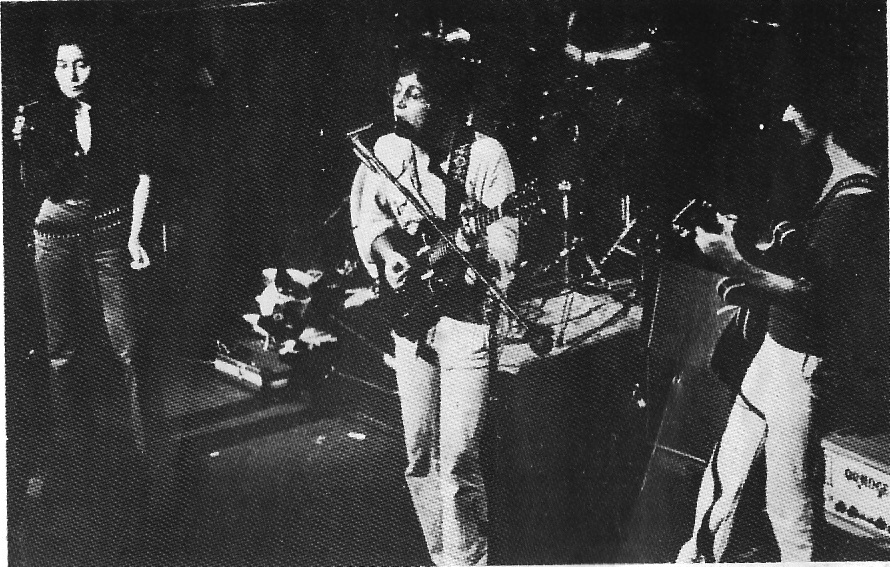 When Zappa was giving his three concerts at the Fillmore East in June,
he was introduced to John Lennon and Yoko Ono,
who had recently moved from London to New York. It was proposed that Lennon and Ono would do a guest appearance at the end
of the late concert that day. Four pieces were prepared, a regular cover song called "Well" and three improvisations. The
ensuing live jam session is more interesting because of its weirdness than for its musical content.
The first improvisation, named "Jamrag" by Lennon and Ono, consisted of Lennon and Ono stuff and Mothers routines, including Zappa's
"King Kong" theme.
When Zappa was giving his three concerts at the Fillmore East in June,
he was introduced to John Lennon and Yoko Ono,
who had recently moved from London to New York. It was proposed that Lennon and Ono would do a guest appearance at the end
of the late concert that day. Four pieces were prepared, a regular cover song called "Well" and three improvisations. The
ensuing live jam session is more interesting because of its weirdness than for its musical content.
The first improvisation, named "Jamrag" by Lennon and Ono, consisted of Lennon and Ono stuff and Mothers routines, including Zappa's
"King Kong" theme.
Scumbag
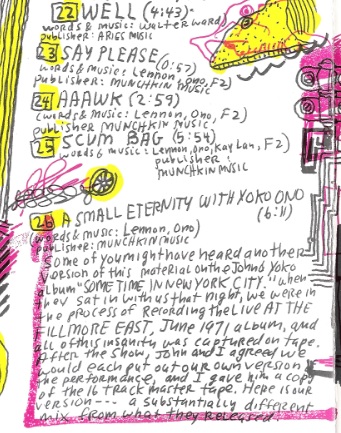 The second one, "Scumbag", was another joint jam, this one around a vamp. The four bars vamp was made up of Lennon chanting "scumbag" every two bars
and a bass motif, played with several variations during this song. The vamp tends to dominate, but there's no use
in listening to the "scumbag" line as if it were a lead melody, it simply won't change. The song
gets better listenable when you devote most of your attention to what the other parts are doing. The score below might
help; the "Scumbag" notes are only a minor part of what's going on in total. As composers of "Scumbag" Lennon, Ono, Kaylan and Zappa
get jointly credited. Yoko Ono is singing and squealing through all pieces and gets a
chance to show what sounds her vocal chords can produce in the last improvisation, while Lennon is feedbacking. It's titled "Au" by Lennon
and herself and "A small eternity
with Yoko Ono" by Zappa.
The second one, "Scumbag", was another joint jam, this one around a vamp. The four bars vamp was made up of Lennon chanting "scumbag" every two bars
and a bass motif, played with several variations during this song. The vamp tends to dominate, but there's no use
in listening to the "scumbag" line as if it were a lead melody, it simply won't change. The song
gets better listenable when you devote most of your attention to what the other parts are doing. The score below might
help; the "Scumbag" notes are only a minor part of what's going on in total. As composers of "Scumbag" Lennon, Ono, Kaylan and Zappa
get jointly credited. Yoko Ono is singing and squealing through all pieces and gets a
chance to show what sounds her vocal chords can produce in the last improvisation, while Lennon is feedbacking. It's titled "Au" by Lennon
and herself and "A small eternity
with Yoko Ono" by Zappa.
Scumbag, 1:03 till 1:15 (midi file).
Scumbag, 1:03 till 1:15 (transcription).
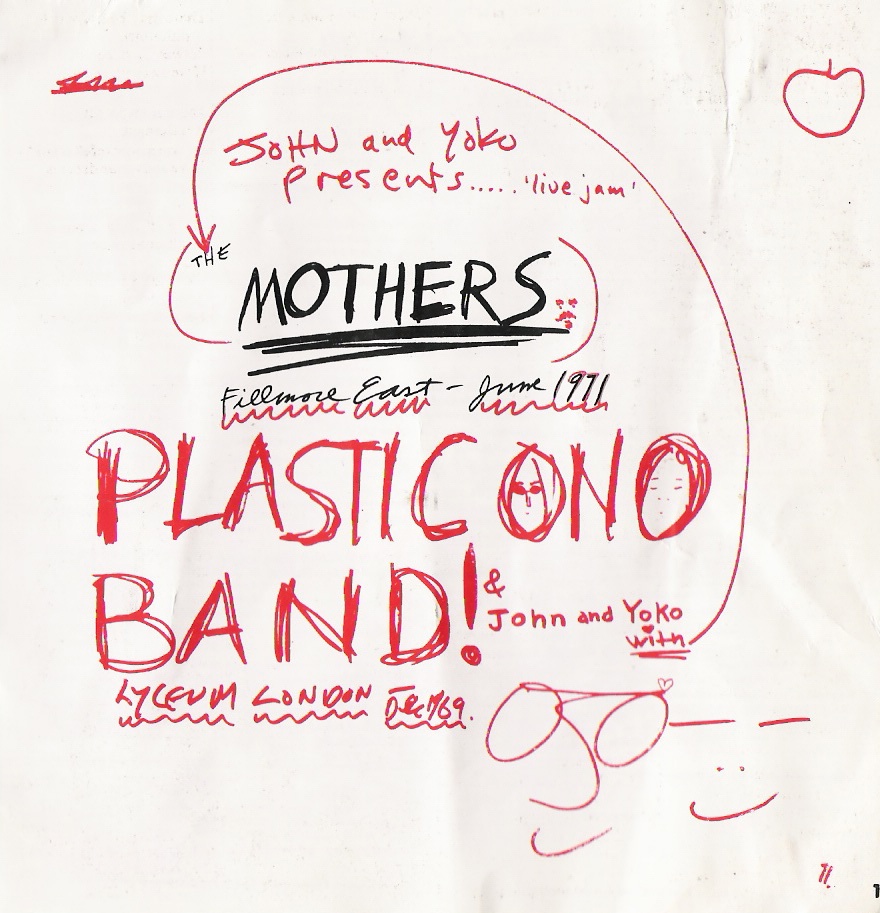 The next day it was agreed upon that both would release a version of their own on their upcoming albums and Zappa gave John
a copy of the tape. Lennon and Ono included this live jam as a bonus on their 1972 double album "Some time in New York City". It's
a political pamphlet with so-called protest songs, half of them by Lennon, half of them by Ono. It sold poorly for Lennon
standards.
Whereas Zappa had parodied
the Sergeant Pepper album sleeve of the Beatles, Lennon now parodied Zappa's Fillmore East cover on his turn, writing all over it in red.
Zappa may have liked this, but he wasn't amused by that he didn't get co-credited for "Jamrag".
On the recent 2005 single CD issue Yoko Ono appears to have skipped most of the jam, the double CD is the original version. For contractual reasons
Zappa couldn't bring out his version that year. It only resurfaced in 1992 on "Playground psychotics". "Jamrag"
got split into "Say please" and "Aaawk", leaving out the "King Kong" theme. The mix of Zappa's "Scumbag" is quite different
from what Lennon's producer Phil Spector did. The guitars aren't in the foreground no more and Howard Kaylan, who was
almost mixed out, is back in business.
The next day it was agreed upon that both would release a version of their own on their upcoming albums and Zappa gave John
a copy of the tape. Lennon and Ono included this live jam as a bonus on their 1972 double album "Some time in New York City". It's
a political pamphlet with so-called protest songs, half of them by Lennon, half of them by Ono. It sold poorly for Lennon
standards.
Whereas Zappa had parodied
the Sergeant Pepper album sleeve of the Beatles, Lennon now parodied Zappa's Fillmore East cover on his turn, writing all over it in red.
Zappa may have liked this, but he wasn't amused by that he didn't get co-credited for "Jamrag".
On the recent 2005 single CD issue Yoko Ono appears to have skipped most of the jam, the double CD is the original version. For contractual reasons
Zappa couldn't bring out his version that year. It only resurfaced in 1992 on "Playground psychotics". "Jamrag"
got split into "Say please" and "Aaawk", leaving out the "King Kong" theme. The mix of Zappa's "Scumbag" is quite different
from what Lennon's producer Phil Spector did. The guitars aren't in the foreground no more and Howard Kaylan, who was
almost mixed out, is back in business.
Say please - Aaawk
"Say please" and "Aaawk" are directed improvisations, credited to Lennon, Ono and FZ. The first little outtake from below is
a sketch of 5 seconds from the beginning of "Say please". The Mothers respond to Zappa's hand signalling with, among others, shouting "ah".
Later on the audience participates. Yoko Ono screams "please" (staff 5). The track ends with another Mothers routine, playing in 5/8.
Say please, 0:05-0:09 (transcription).
Aaawk, 2:12-2:25 (transcription).
"Aaawk" can be subdivided into four little blocks. During the first three blocks you can hear three different bass vamps with the keyboard
players soloing. This title starts as normal diatonic music, but is getting atonal and extravagant towards the end.
During the last block the bass is silencing, while the drummer is beating standard 4/4. It's this block the sample
from above is taken from. It has everybody improvising freely and pretty irregularly (except for the absent bass).
Neither example is suited for being converted into midi format.
Photos/images:
- Yoko Ono, John Lennon and FZ.
- Tracklist of the sequence with comments (Playground psychotics CD, drawn by Cal Schenkel).
- Fillmore East cover by Cal Schenkel with additions in pink by Al Steckler, John and Yoko.
Source: Some time in New York city CD booklet.
PLAYGROUND PSYCHOTICS
"Some time in New York City" is an album you can afford to make when you're already rich and famous, when there's no record company executive trying to obstruct things because it's less commercial. The same applies to Zappa's "Playground psychotics". To quote from the liner notes: "This album moves beyond mere rock 'n roll into the dangerous realm of social anthropology. It offers to younger musicians the chance to participate vicariously in the touring world of the early 1970's (way back when it was still fun to do)". And that is exactly what this double CD does. If you go along with Zappa's intentions it becomes enjoyable. Nearly half of the material is made up of takes from recorded conversations, while being on the road. The combination with music from three shows works well for building up a documentary and if things had been filmed as well it would have been nice to have on DVD.
Brixton still life
Musically there's little news. The jam with John Lennon from above is on it, some collages and
several known pieces, that don't differ much from their original releases. Included are two solos, one on keyboard during "Billy
the mountain" and a guitar solo by Zappa called "Brixton still life". It starts over a pedestrian beat on D, the key
thus being D Mixolydian. After 50 seconds the
bass player sets the meter to 4/4. It is from this point onwards that the transcribed section from below is taken.
Brixton still life, 0:50 till 1:20 (midi file).
Brixton still life, 0:50 till 1:20 (transcription).
"Playground psychotics" was constructed in 1992 when Zappa was severely ill. It must have taken quite some time going through the
recorded conversations, but I have the impression that more could have been made of the music if Zappa
would have had more time. I don't know to what
extent the concerts got recorded, but there are some things on the bootlegs from this period, that I personally would have welcomed on this CD. See the previous
section for three examples. There's also a song called "What will this evening bring me this morning" intro to the groupies opera on "Tengo na minchia tanta".
In Zappa's own catalogue this song can only be found on the movie version of "200 Motels" at about 1h:12. It's a variant upon
"What will this morning bring me this evening" with a "go to the club..." section added to it. Years later, in 2021, the ZFT included several takes
of this title in their "200 Motels, 50th anniversary edition" release.
Zanti serenade
"Zanti serenade" is the concert opener of the Rainbow theater show with improvisations on sythesizers. It's attributed to
Underwood, Preston and Zappa. This isn't material to be transcribed and converted into midi format. Zappa describes it as
a sound check in front of the audience, while the members of this audience probably thought it was some sort of avant garde extravaganza.
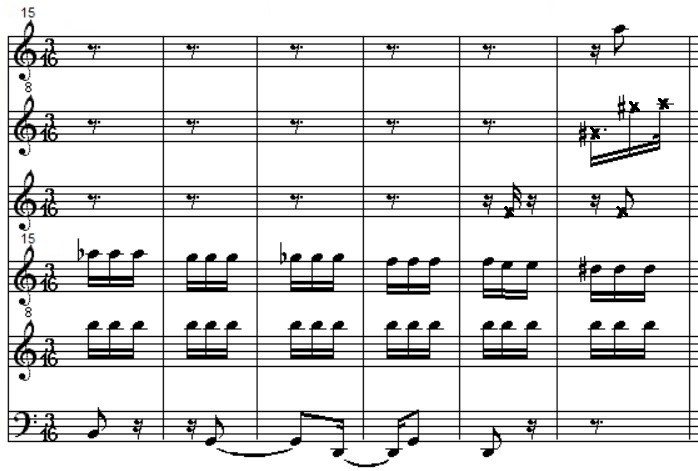
The fragment above is played between 1:07 and 1:11 on "Playground psychotics". That specific track is an outtake of the actual concert
opener, that can be found in full on the 2022 ZFT release "The Mothers 1971". The pulsing B is the constant factor, other elements can be by approximation.
It's made up of a number of layers:
- Staves 1-3: sort of a crash.
- Staff 4: downwards chromatic line.
- Staff 5: a pulse.
- Staff 6: bass melody.
Note the wide range of the pitches. I've used both the ottava and quindecima sign.
Don't eat there - Super grease
"Don't eat there" is a collage, starting with the Mothers improvising and Zappa playing a figure on guitar, that you might call
the central theme. This figure is a fast chromatic lick, presented in staff 1 from "bar 1" in the fragment below. It gets varied upon two times.
It has no meter and the transcription is by appromation only.
Don't eat there, 0:24-0:29 (midi file).
Don't eat there, 0:24-0:29 (transcription).
This live section gets followed by a transitory vamp in 6/8, that moves over into a field recording with the Mothers ordering
breakfast or lunch in a restaurant. Next they talk about a club they visited the night before with an amateur band playing. At the end the
6/8 vamp returns.
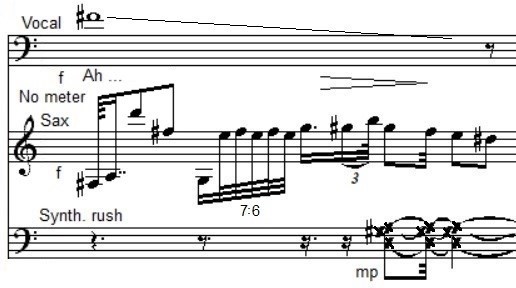
"Super grease" is another improvisation, directed by Zappa. Like the previous song it has eating in restaurants as subject with the Mothers being credited for the words.
This one isn't fit for transcribing either. The snippet above is an approximation of its first three seconds. It features
a sustained downwards moving sung note, an irregular sax melody and a rushing dissonant synthesizer chord/cluster, of which the notes
can't be discerned with certainty.
A typical soundcheck
"A typical soundcheck" is one of the many short excerpts from the road tapes to be found on "Playground psychotics". It sounds as a collage of people talking and a small fragment
with the band jamming, apparently during a soundcheck. The example below features Zappa on guitar and the rhythm section.
A typical soundcheck, 0:37-0:58 (midi file).
A typical soundcheck, 0:37-0:58 (transcription).
To a large degree it's using A minor pentatonic. A B is getting used in bars 6-7, so it can also be interpreted as diatonic with one note being avoided, the F/F#.
This is getting addressed at at the bottom of the Burnt weeny section of this study, the seventh diatonic note paragraph.
Once upon a time - Sofa (1971) - Divan
Regarding the musical sections "Playground psychotics" is a live compilation with several tracks being released before. The ones with the earlier versions
included in this study are:
The following block is quoted from http:\\www.theturtles.com in 2005, a little interview with Flo and Eddie
reflecting upon their time with Frank from 1970 till 1993: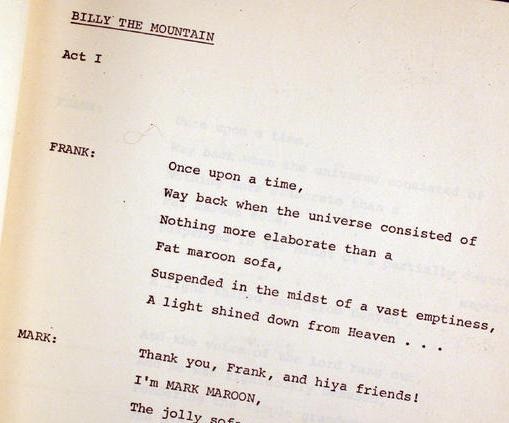 The touring with Flo and Eddie ended abruptly in December 1971 with disasters for the band. At a Montreux gig in November the concert hall took
fire and the touring equipment got destroyed. Worse, Zappa got thrown off a stage in
London the next month, where he had to be taken to a hospital with both legs broken. Zappa
was forced to recuperate at his home in L.A. Indirectly this meant the end of The Mothers of
Invention in this set up.
The touring with Flo and Eddie ended abruptly in December 1971 with disasters for the band. At a Montreux gig in November the concert hall took
fire and the touring equipment got destroyed. Worse, Zappa got thrown off a stage in
London the next month, where he had to be taken to a hospital with both legs broken. Zappa
was forced to recuperate at his home in L.A. Indirectly this meant the end of The Mothers of
Invention in this set up.
The last piece Zappa had been working on for this specific band was a series of songs that
fans gave the name "The sofa suite". In 2011 the ZFT released "Carnegie Hall", including this series of songs,
giving it the name "Divan" after its closing track. Till then it could only be heard in its entirety on the "Fire!" bootleg with the Montreux concert on it. The suite is made up of
"Once upon a time", "Sofa", "Stick it out" and "Divan". The first two songs are present on "You can't do that on stage anymore
Vol. I". "Stick it out" became part of "Joe's garage" from 1979 in a different context, thus released eight years after it was written.
"Divan" can be found on "Playground psychotics". Scattered around in this way the original story can't be
detected anymore in Zappa's own releases.
Parts of the spoken monologues are left out on these CDs, so even when you play these songs as a sequence, the intentions of the
songtexts remain vague. Zappa had the text typed out as a play or script in combination with "Billy the mountain". A copy
got auctioned at www.backstageauctions.com in 2009, from which the sample to the right is taken. The same as with the two previous
plays (the groupie opera and "Billy the mountain"), "The sofa suite" is made up of sections where the lyrics stand central
and parts where the music takes the lead. "Once upon a time" and "Divan" are the textual sections, both using a vamp.
The "Once upon a time" vamp is in C in 12/8 time. In the transcription it's represented by staff 4 in bar 1. At this specific
point the chorus is singing in German over the vamp ("Gib zu mir etwas fürs Bodenbelag unter diesem fätten fliessenden Sofa").
They are singing in three parts, forming a joint harmony progression. Most of the time however the band members are
talking and speechwise singing.
In bar 3 Zappa responds speechwise, translating the previous German sentence ("And of course, ladies and gentlemen, that means
give me a bit of flooring under this fat floating sofa").
The "Divan" vamp is chromatic; it can't be assigned to a specific key. Its lyrics are partially in German and really weird.
The chorus represents the vamp, whereas Zappa is speechwise singing. If I'm
not mistaken, the transcribed section contains part of the following text block:
- Chorus: Laken von gebratenem Wasser.
(German for sheets of fried water.)
- FZ: Sheets of dry wall and ruffing.
- Chorus: Laken von dry wall und roofing.
- FZ: Sheets of large deprived Rhumba.
- Chorus: Laken von riesigen tief-gebadenem Rhumba.
(German for sheets of giant deeply-bathed Rhumba.)
Once upon a time, section (midi file).
Sofa (1971), opening (midi file).
Divan, 0:50 till 1:08 (midi file).
Once upon a time, section (transcription).
Sofa (1971), opening (transcription).
Divan, 0:50 till 1:08 (transcription).
Of the various "sofa" executions the two of its first release on "One size fits all" (1974) are relatively homophonic (except for the example as included
in the One size fits all section).
The "In New York" version contains the counterpoint figure as described in the Weasels ripped my flesh section of this study. This 1971 one allows
much more freedom for the keyboard players. Bars 1-7 are specific for the original 1971 performance; they fit
in well with the comedy character of the shows. Apart from being in 3/4 this one includes the archetype waltz steps
in bars 9-11. Interesting is the figure the keyboards are playing via triplets in bars 24-26, a clear example
of the more independent keyboard part in this version. The keyboard is here shortly playing in 4/4 against the 3/4 of the melody.
"Sofa" begins in C (bars 1-13) and then modulates to G Mixolydian,
simply by changing from C as key note to G as pedal note (these two keys use the same notes).
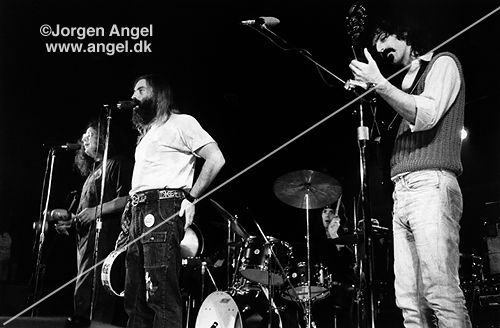 Mark Volman, Howard Kaylan, Aynsley Dunbar and FZ.
Mark Volman, Howard Kaylan, Aynsley Dunbar and FZ.
Photo by Jorgen Angel, used with permission.
Other tracks from Playground psychotics
- "Sleeping in a jar": see the Zappa's teens section.
- "Sharleena": see the Chunga's revenge section.
- "Status back baby": see the Mystery disc-Projects section.
- "Concentration moon": see the We're only in it for the money section.
- Mom & dad: the score of this song is included in the Frank Zappa Songbook vol. I, pages 84-89.
- "Intro to Music for low budget orchestra": see the Studio tan section.
- "Billy the mountain": in this case a section from the "Playground psychotics"
version is included in the Just another band from L.A. section.
"What did you think of Frank Zappa? Whatever happened between you guys and
Frank? Did you remain friends?
Answer:
Howard: "Frank was an icon for a generation, and a true genius...also one of
the greatest guitar players...."
After the incident in London, England, Mark and Howard continued touring
with the members of The Mothers. This was the first Flo & Eddie Band.
Howard: "Yes, we DID see Frank after the Rainbow Theatre accident...It took a
while, but Frank sat in with us in NYC at the Bottom Line one year, and we
sat in with his band in Detroit the year after...."
"Toward the end, we became good friends again, going up to his famous studio
and watching our old concert footage; laughing about the good old days. He
knew that the clock was ticking but he kept chain-smoking, coffee drinking
and eating anchovy pizza...The man was one of the few real geniuses I've
ever had the honour to work with."
In addition to a couple of live onstage guest appearances, in 1987 Mark and
Howard reunited with Frank....
Howard:"Frank's original intention was to get the "Filmore East" band back
together to do one huge world tour...."
"So we got together in L.A. at a rehearsal hall for two days...."
Unfortunately, it was not to be. Apparently there are tapes of the
rehearsals in existence somewhere.
When asked which of his bands were Frank's favourites, Gail Zappa was quoted
in an interview as saying he liked all of them, but mentioned Mark, Howard
and Aynsley Dunbar as particular favourite members for their talent and
senses of humour."
